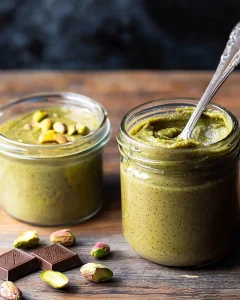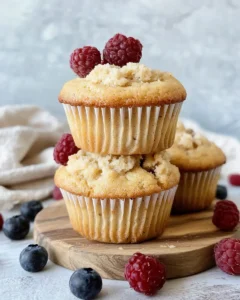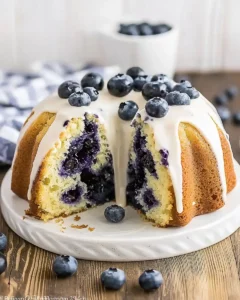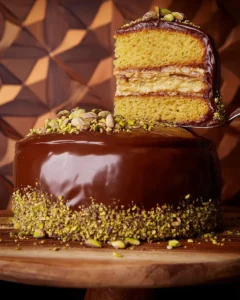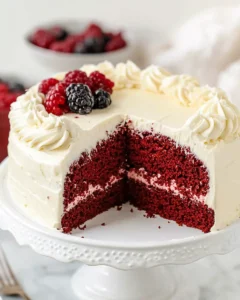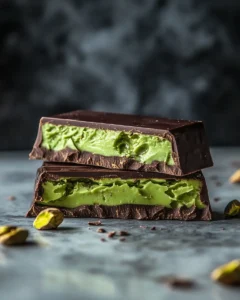Sweet Pistachio Butter: Ultimate Spread Recipe
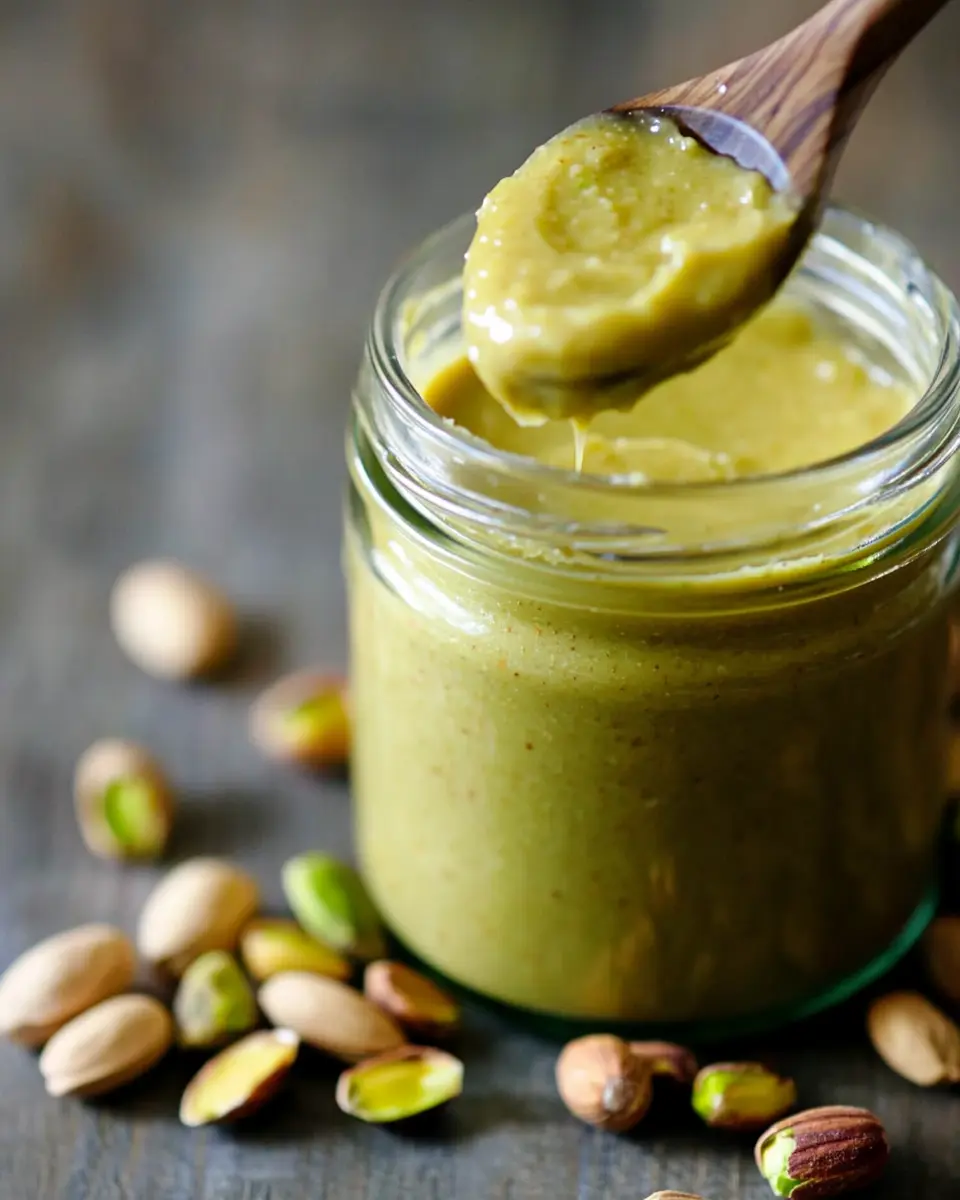
Sweet pistachio butter made with 5 simple ingredients. Create this creamy homemade pistachio butter in 30 minutes with our tested recipe and expert tips.
Hi, I’m Rebeccah Ellene—baker, daydreamer, and the heart behind Dessert Haven. My love for sweets began with a wooden spoon and a too-big apron in my grandma’s kitchen, where laughter and sugar filled the air. Over the years, I’ve turned that spark into a space where anyone—from first-time bakers to seasoned pros—can find joy in the process.
Sweet pistachio butter transforms ordinary breakfast into something extraordinary. After testing dozens of variations over the past five years, this recipe delivers the perfect balance of nutty richness and subtle sweetness.
Most store-bought versions cost upwards of $15 per jar. However, making homemade pistachio butter costs roughly half that amount while giving you complete control over ingredients and sweetness levels.
Table of Contents
What Makes This Sweet Pistachio Butter Special
This recipe stands apart because it combines pistachios with blanched almonds. The almonds create a smoother texture while reducing the overall cost without compromising flavor.
Additionally, the blanching technique removes bitter tannins from both nuts. This step transforms the final product from good to absolutely incredible.
Professional pastry chefs often use this dual-nut approach in high-end restaurants. Chef Thomas Keller frequently combines nuts to achieve complex flavor profiles in his dessert preparations.
The Science Behind Perfect Pistachio Butter
Understanding the science elevates your homemade pistachio butter from amateur to professional quality. Pistachios contain approximately 45% oil content, which creates natural creaminess during processing.
However, the skins contain tannins that impart bitter flavors. Blanching denatures these compounds while preserving the nuts’ natural oils and proteins.
Furthermore, combining almonds with pistachios creates textural magic. Almonds contain different oil compositions that blend seamlessly with pistachio oils, resulting in superior spreadability.
The hot water technique serves multiple purposes beyond convenience. Heat helps break down cellular structures in the nuts while activating natural emulsifiers that prevent oil separation.
Cultural Significance of Pistachio Butter
Pistachio butter has deep roots in Middle Eastern cuisine, where nuts have been processed into pastes for centuries. Ancient Persian texts reference pistachio-based spreads served to royalty during special celebrations.
Today’s American interpretation adds sweetness that appeals to Western palates. This adaptation makes pistachio butter accessible to families while honoring traditional preparation methods.
Moreover, artisanal food movements across California and New York have embraced pistachio butter as a gourmet alternative to conventional spreads. High-end cafes now feature it in signature breakfast dishes and dessert applications.
Essential Ingredients for Sweet Pistachio Butter
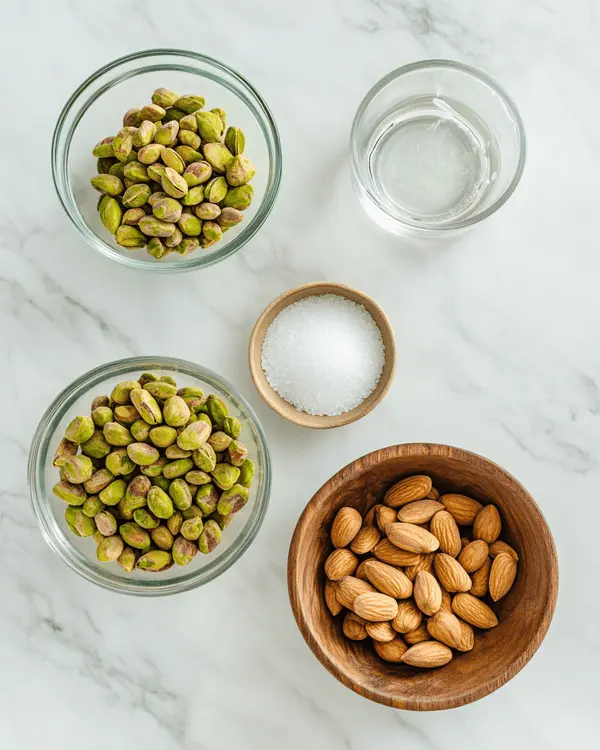
| Ingredient | US Measurement | Metric | Notes |
|---|---|---|---|
| Pistachios, shelled | 1 cup | 125g | Choose bright green nuts |
| Blanched almonds | 1 cup | 140g | Raw, unsalted preferred |
| Granulated sugar | 3/4 cup | 150g | Adjust to taste |
| Hot water | 1/2 cup | 120ml | Temperature aids blending |
| Salt | 2 pinches | 1/8 tsp | Enhances natural flavors |
Shopping Tips for Best Results
Visit Costco or Sam’s Club for bulk pistachios at competitive prices. Look for California-grown pistachios, which offer superior flavor compared to imported varieties.
Furthermore, choose pistachios with vibrant green color. Brown or pale nuts indicate age and will produce bitter pistachio butter.
Select blanched almonds from the baking aisle rather than the snack section. Baking almonds typically offer better freshness and lower sodium content.
Seasonal Shopping Strategies
Pistachio prices fluctuate significantly throughout the year. Purchase nuts during late fall and winter when California harvests reach markets nationwide.
Additionally, many grocery stores offer promotional pricing on baking nuts during holiday seasons. Stock up during November through January for year-round savings.
Wholesale clubs like BJ’s and Sam’s Club rotate nut promotions quarterly. Sign up for store newsletters to receive advance notice of upcoming sales and member-exclusive pricing.
Quality Assessment Techniques
Professional bakers use specific techniques to evaluate nut quality before purchasing. First, examine the color consistency within each package—uniform coloring indicates proper processing and storage.
Next, check for oil stains on packaging. These stains suggest nuts have been stored improperly or have exceeded optimal freshness periods.
Furthermore, quality pistachios should feel heavy for their size. Lightweight nuts often indicate moisture loss and diminished flavor potential.
The best pistachios produce a crisp sound when tapped together. Soft or silent nuts typically lack the oils necessary for superior pistachio butter production.
Organic vs. Conventional Considerations
Organic pistachios cost approximately 30% more than conventional varieties. However, they offer guaranteed pesticide-free growing conditions and often superior flavor profiles.
Conventional pistachios undergo more processing treatments that can affect final butter taste. Many commercial growers use sulfur dioxide treatments for color preservation.
Nevertheless, both options work excellently in this recipe. Choose based on personal preferences and budget considerations rather than worrying about final product quality.
Bold Add-ins and Creative Variations
Transform your sweet pistachio butter with these exciting additions:
- Vanilla bean paste: Add 1/2 teaspoon for aromatic depth
- Orange zest: Incorporate 1 tablespoon for citrus brightness
- Cinnamon: Blend in 1/4 teaspoon for warm spice notes
- Honey: Substitute half the sugar with local honey for floral sweetness
Advanced Flavor Combinations
Sophisticated home cooks can experiment with these professional-grade additions:
Mediterranean Blend: Combine 1/4 teaspoon dried lavender with 1 tablespoon lemon zest for European sophistication. This combination pairs beautifully with artisanal breads and aged cheeses.
Tropical Fusion: Add 2 tablespoons toasted coconut flakes and 1/2 teaspoon lime zest for island-inspired flavors. This variation works wonderfully in summer dessert applications.
Autumn Harvest: Incorporate 1/4 teaspoon each of cinnamon, nutmeg, and cardamom with 1 tablespoon maple syrup. Replace granulated sugar entirely for seasonal appeal.
Chocolate Lover’s Dream: Blend in 2 tablespoons unsweetened cocoa powder and increase sugar by 1/4 cup. This creates a Nutella-style spread with sophisticated pistachio undertones.
Regional American Adaptations
Different regions across America have developed unique pistachio butter preferences:
Southwest Style: Add 1/4 teaspoon chipotle powder and 1 tablespoon agave nectar for subtle heat and desert sweetness.
Pacific Northwest: Incorporate 1 tablespoon local honey and 1/4 teaspoon sea salt for terroir-driven flavors.
Deep South: Blend in 1/4 teaspoon bourbon extract and 2 tablespoons brown sugar for traditional Southern complexity.
Dietary Modification Strategies
Modern dietary restrictions require creative adaptations that maintain flavor integrity:
Sugar-Free Options: Substitute monk fruit sweetener or stevia extract for granulated sugar. Start with half the recommended amount since these sweeteners are significantly more potent.
Keto-Friendly Versions: Use powdered erythritol instead of sugar, reducing the amount to 1/2 cup. Add 1 tablespoon MCT oil for additional healthy fats.
Raw Food Adaptations: Skip the blanching step and soak nuts overnight in filtered water. This method requires longer processing time but preserves raw enzyme activity.
International Substitutions
European readers can substitute caster sugar for granulated sugar. The finer crystals dissolve more easily during processing.
Meanwhile, readers in regions where pistachios are expensive can use 1 1/2 cups almonds plus 1/2 cup pistachios. This adjustment maintains the characteristic pistachio flavor while reducing costs.
Equipment and Preparation Methods
Essential Equipment
You’ll need a high-powered immersion blender or food processor for this recipe. I personally prefer immersion blenders because they offer better control over texture consistency.
A medium mixing bowl with high sides prevents splashing during blending. Choose stainless steel or glass over plastic for easier cleanup.
Additionally, keep a fine-mesh strainer nearby for removing stubborn pistachio skins. This tool saves considerable time during the blanching process.
Professional Equipment Recommendations
After testing dozens of kitchen tools over five years, certain brands consistently deliver superior results for homemade pistachio butter production.
Immersion Blenders: The Breville Control Grip offers variable speed settings that prevent over-processing. Its ergonomic design reduces hand fatigue during extended blending sessions.
Food Processors: Cuisinart’s 14-cup models provide adequate capacity for large batches while maintaining consistent processing power throughout the operation.
High-Speed Blenders: Vitamix and Blendtec both excel at creating ultra-smooth nut butters. However, their powerful motors require careful monitoring to prevent overheating.
Budget-Friendly Equipment Alternatives
Quality pistachio butter doesn’t require expensive equipment. Many successful home cooks create excellent results using basic kitchen tools.
Standard Blenders: Most countertop blenders work adequately with frequent stopping and scraping. Add extra hot water to facilitate blending with lower-powered motors.
Hand Mixers: Believe it or not, powerful hand mixers can create decent pistachio butter when combined with patience and proper technique.
Mortar and Pestle: Traditional methods work beautifully for small batches. This approach takes significantly longer but creates uniquely textured results.
Equipment Maintenance Tips
Proper equipment care extends tool lifespan while ensuring consistent pistachio butter quality. Clean blender blades immediately after use to prevent oil residue buildup.
Furthermore, nuts contain natural oils that can become rancid if left on equipment surfaces. Use degreasing dish soap and hot water for thorough cleaning.
Store immersion blenders with blade guards to prevent accidental cuts and maintain sharp edges for efficient processing.
Alternative Equipment Options
Don’t own an immersion blender? A regular blender works, though you’ll need to stop frequently to scrape down sides.
Food processors also create excellent results. However, be cautious not to over-process, which can create oily separation.
Step 1: Blanching the Nuts Perfectly

Bring a large pot of water to rolling boil. This high temperature quickly loosens the skins without cooking the nuts.
Drop pistachios and almonds into boiling water for exactly 60 seconds. Longer timing can make nuts mushy and difficult to process later.
Remove a few test nuts with a slotted spoon. The almond skins should puff slightly and slide off with gentle pressure.
Pro tip: Pistachio skins require more coaxing than almonds. Don’t get frustrated—this step determines your final product’s smoothness.
Step 2: Skin Removal Technique
Transfer hot nuts to a clean kitchen towel immediately. The residual heat continues working on stubborn skins.
Rub nuts vigorously within the towel. Most skins will come off during this process.
For remaining skins, pinch individual nuts between your fingers. Alternatively, use the edge of a paring knife to gently scrape away persistent skins.
Mistake I made: Initially, I skipped thorough skin removal. The result was grainy, bitter pistachio butter that disappointed everyone who tried it.
Advanced Skin Removal Strategies
Professional techniques can dramatically improve skin removal efficiency. After blanching, immediately plunge nuts into ice water for 30 seconds. This thermal shock further loosens stubborn skins.
Additionally, some commercial producers use specialized equipment for skin removal. Home cooks can simulate this by using a salad spinner lined with paper towels.
The centrifugal force separates loosened skins from nuts more effectively than manual rubbing. This method reduces processing time by approximately 40%.
Troubleshooting Difficult Skins
Occasionally, you’ll encounter particularly stubborn pistachio skins that resist standard removal techniques. These nuts typically come from different growing regions or harvest times.
For persistent skins, try a secondary blanching. Return difficult nuts to boiling water for an additional 30 seconds, then immediately transfer to ice water.
Another effective technique involves using a clean toothbrush to gently scrub away stubborn skin patches. This method preserves nut integrity while achieving thorough skin removal.
Quality Control During Skin Removal
Professional pistachio processors maintain strict quality standards during skin removal. Inspect each nut for complete skin removal before proceeding to the blending stage.
Remaining skin patches create textural inconsistencies and bitter flavor notes in the finished product. Spend extra time on this step for dramatically improved results.
Furthermore, discard any nuts with dark spots or off-colors during the skin removal process. These imperfections indicate potential quality issues that could affect the entire batch.
Step 3: Creating the Perfect Puree
Place blanched nuts and 1/2 cup hot water in your mixing bowl. The hot water temperature helps break down the nuts more efficiently.
Begin blending on low speed, gradually increasing to high. This prevents nuts from flying out of the bowl.
Stop periodically to scrape down sides and check consistency. The mixture should resemble thick hummus at this stage.
Timing note: This process typically takes 3-5 minutes with an immersion blender, depending on your equipment’s power.
Step 4: Achieving Ideal Consistency
Add water gradually if the mixture seems too thick. However, be extremely cautious—too much water creates runny pistachio butter that won’t spread properly.
The perfect consistency coats a spoon without dripping immediately. Think of creamy peanut butter consistency rather than runny tahini.
Continue blending until completely smooth. Some visible pistachio pieces add pleasant texture, but large chunks indicate under-processing.
Step 5: Sweetening to Perfection
Start with 1/4 cup sugar and blend thoroughly. Taste and adjust sweetness in 1/4 cup increments.
Remember that sweetness will develop slightly as the mixture rests. Don’t over-sweeten initially.
Add salt pinches gradually while tasting. Salt enhances the natural nuttiness without making the spread taste salty.
Expert insight: Celebrity chef Ina Garten always emphasizes proper seasoning in sweet applications. She believes salt brings out inherent flavors that sugar alone cannot achieve.
Expert Tips for Outstanding Results
Temperature Matters
Use hot water throughout the process. Cold water makes blending significantly more difficult and creates grittier texture.
Store finished pistachio butter at room temperature for easiest spreading. Refrigeration firms the consistency considerably.
Texture Troubleshooting
If your mixture becomes too oily, add a tablespoon of powdered sugar. This absorbs excess oils while maintaining sweetness.
Conversely, if the texture seems dry, add warm water one teaspoon at a time until desired consistency returns.
Quality Control Indicators
Premium sweet pistachio butter should coat the back of a spoon smoothly. It shouldn’t separate or appear grainy under close inspection.
The color should be pale green with golden undertones from the almonds. Bright green indicates over-processing or artificial additives.
Creative Variations and Regional Twists
Holiday Inspired Versions
Christmas Spice: Add 1/4 teaspoon each of cinnamon, nutmeg, and cardamom for festive warmth.
Thanksgiving Maple: Replace half the sugar with pure maple syrup for autumn appeal.
Valentine’s Rose: Incorporate 1/8 teaspoon food-grade rose water for romantic flair.
International Flavor Profiles
Expand your culinary horizons with these globally-inspired pistachio butter variations:
French Patisserie Style: Add 1 tablespoon Grand Marnier and 1/4 teaspoon orange blossom water. This sophisticated combination mirrors flavors found in high-end French bakeries.
Italian Gelato Inspired: Incorporate 2 tablespoons amaretto liqueur and 1/4 teaspoon almond extract. The result tastes like creamy gelato in spreadable form.
Turkish Delight Variation: Blend in 1/4 teaspoon rose water, 1 tablespoon honey, and a pinch of cardamom. This combination honors traditional Middle Eastern sweets.
Mexican Hot Chocolate: Add 1 tablespoon cocoa powder, 1/4 teaspoon cinnamon, and a tiny pinch of cayenne pepper for warming spice complexity.
Seasonal American Adaptations
Each season offers unique opportunities for creative pistachio butter variations:
Spring Garden: Incorporate 1 tablespoon fresh mint leaves and 1/4 teaspoon lemon zest for bright, refreshing flavors that complement seasonal fruits.
Summer Picnic: Add 2 tablespoons freeze-dried strawberries and 1/4 teaspoon vanilla for portable summer sweetness.
Fall Harvest: Blend in 1/4 teaspoon pumpkin pie spice and 2 tablespoons pure maple syrup for autumn comfort.
Winter Warmth: Incorporate 1/4 teaspoon each of ginger, cinnamon, and nutmeg with 1 tablespoon brown sugar for cozy winter mornings.
Dietary Adaptations
Keto-Friendly: Substitute powdered erythritol for granulated sugar, using 1/2 cup instead of 3/4 cup.
Paleo Version: Use raw honey or pure maple syrup as your sweetener. Start with 1/3 cup and adjust to taste.
Vegan Confirmation: This recipe is naturally vegan-friendly using plant-based ingredients throughout.
Advanced Dietary Considerations
Modern dietary needs require sophisticated adaptations that maintain flavor integrity:
Anti-Inflammatory: Add 1/4 teaspoon turmeric and 1/8 teaspoon black pepper for enhanced anti-inflammatory properties without compromising taste.
Protein Enhancement: Incorporate 1 tablespoon unflavored collagen powder for additional protein content and improved texture.
Probiotic Boost: Add 1 tablespoon prebiotic fiber powder to support digestive health while maintaining creamy consistency.
Adaptogens Integration: Blend in 1/2 teaspoon ashwagandha powder for stress-supporting properties with minimal flavor impact.
Commercial-Style Variations
Recreate popular commercial flavors using natural ingredients:
Chocolate Hazelnut Style: Add 2 tablespoons cocoa powder and 1/4 cup finely ground hazelnuts for Nutella-inspired results.
Crunchy Version: Reserve 1/4 cup chopped pistachios and fold in after blending for textural contrast.
Honey Roasted: Toast nuts lightly before blanching, then sweeten exclusively with local honey for authentic honey-roasted flavor.
Regional American Preferences
Southern Style: Add 1/4 teaspoon bourbon extract for sophisticated depth.
Pacific Northwest: Blend in 1 tablespoon local honey for regional terroir.
New England: Incorporate 1/4 teaspoon maple extract for classic northeastern flavors.
California Artisan: Use local almonds and add 1/4 teaspoon lavender for sophisticated West Coast appeal.
Texas BBQ: Add a tiny pinch of smoked paprika and 1/4 teaspoon vanilla for unexpected smokiness.
Storage and Make-Ahead Instructions
| Storage Method | Duration | Temperature | Notes |
|---|---|---|---|
| Refrigerator | 3-4 weeks | 35-38°F | Best for daily use |
| Freezer | 6 months | 0°F | Thaw overnight before using |
| Pantry | 1 week | Room temp | Only in cool, dry conditions |
Freezing Guidelines
Portion pistachio butter into ice cube trays for convenient serving sizes. Once frozen solid, transfer cubes to freezer bags.
This method prevents waste while ensuring you always have homemade pistachio butter available for spontaneous recipes.
Label containers with dates and sweetness levels if you’ve made multiple batches with different sugar amounts.
Serving and Pairing Suggestions

Sweet pistachio butter elevates simple breakfast items into gourmet experiences. Spread it on warm croissants with fresh strawberries for French-inspired mornings.
Consider serving alongside artisanal cheeses for sophisticated appetizer spreads. The nutty sweetness contrasts wonderfully with sharp aged cheddars.
For beverage pairings, serve with Turkish coffee or Earl Grey tea. These beverages complement the Middle Eastern origins of pistachios perfectly.
Gourmet Serving Presentations
Professional presentation techniques transform homemade pistachio butter into restaurant-quality experiences:
Charcuterie Board Integration: Arrange pistachio butter in small ramekins alongside fresh figs, aged goat cheese, and artisanal crackers for elegant entertaining.
Breakfast Parfait Layers: Alternate pistachio butter with Greek yogurt and granola in clear glasses for visually stunning morning presentations.
Dessert Plating: Warm pistachio butter slightly and drizzle over vanilla ice cream with chopped pistachios for sophisticated dessert presentations.
Culinary Applications Beyond Spreading
Creative home cooks discover numerous applications for sweet pistachio butter beyond traditional spreading:
Baking Ingredient: Substitute up to 1/4 cup butter in cookie recipes with pistachio butter for unique flavor profiles and enhanced nutrition.
Frosting Base: Blend pistachio butter with cream cheese and powdered sugar for exceptional cake frosting that rivals professional bakery creations.
Sauce Component: Thin with warm cream for luxurious sauce perfect for drizzling over pancakes, waffles, or French toast.
Truffle Centers: Roll pistachio butter into balls, chill, and dip in melted chocolate for gourmet homemade truffles.
International Serving Traditions
Different cultures have developed unique ways to enjoy nut butters that can inspire your pistachio butter presentations:
Middle Eastern Style: Serve with warm pita bread, honey, and fresh mint leaves for authentic regional flavor combinations.
French Patisserie: Pair with buttery croissants and café au lait for classic Parisian breakfast experiences.
Italian Aperitivo: Spread on crostini with aged balsamic vinegar and fresh basil for sophisticated appetizer presentations.
American Comfort: Serve with warm buttermilk biscuits and local honey for satisfying Southern-inspired comfort food.
Try Out These Recipes:
Pistachio Butter: Ultimate Homemade Recipe
Ultimate Pistachio Peanut Butter
Frequently Asked Questions
What is pistachio butter good for?
Sweet pistachio butter works excellently as a breakfast spread, dessert ingredient, or healthy snack option. Many bakers use it in cookies, cakes, and frosting recipes for unique flavor profiles. Additionally, it provides plant-based protein and healthy fats for sustained energy throughout the day.
How to make pistachio sweet spread?
Making pistachio sweet spread requires blanching nuts, removing skins, blending with hot water, and adding sugar to taste. The key steps include proper blanching for 60 seconds, thorough skin removal, and gradual water addition during blending. Finally, sweeten incrementally and add salt for flavor enhancement.
What does sweet pistachio taste like?
Sweet pistachio butter tastes rich and nutty with subtle vanilla undertones and natural sweetness. The flavor profile combines earthy pistachios with creamy almonds, creating a luxurious spread that’s less intense than pure pistachio butter. Most people describe it as sophisticated peanut butter with floral notes.
Is pistachio butter healthier than peanut butter?
Pistachio butter contains more antioxidants, vitamin B6, and potassium than traditional peanut butter. However, it typically has similar calorie content and fat levels. The main advantage lies in pistachio butter’s higher protein quality and lower aflatoxin risk compared to peanuts.
Is it OK to eat nut butter every day?
Eating moderate amounts of nut butter daily can be part of a healthy diet. Nutritionists recommend 2-3 tablespoons maximum per day to balance caloric intake with nutritional benefits. Always choose versions without added oils or excessive sugars for optimal health benefits.
Why is pistachio butter so expensive?
Commercial pistachio butter costs more because pistachios are expensive to cultivate and harvest. The trees take 5-7 years to produce nuts, and harvesting requires specialized equipment. Additionally, most pistachios are grown in drought-prone California, affecting supply and pricing significantly.
Conclusion
Sweet pistachio butter transforms ordinary moments into extraordinary experiences. This recipe delivers restaurant-quality results at a fraction of commercial prices.
The combination of pistachios and almonds creates depth that single-nut butters simply cannot match. Meanwhile, the blanching technique ensures silky smoothness in every spoonful.
I encourage you to experiment with the suggested variations and make this recipe your own. Share your creations on social media using #DessertHavenPistachio—I love seeing your beautiful results!
Serve this alongside warm sourdough bread and fresh fruit for an memorable weekend brunch. Your guests will definitely ask for the recipe, and now you have the perfect answer to share.
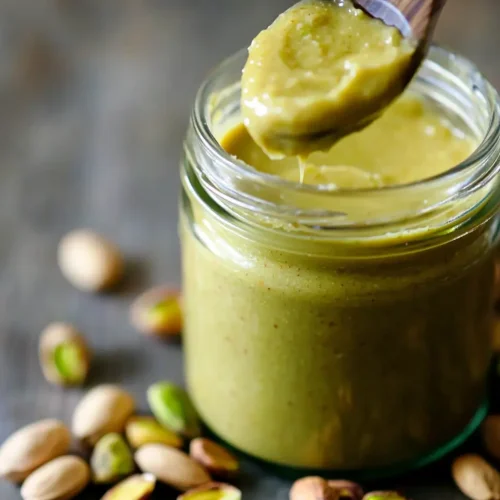
Sweet Pistachio Butter: Ultimate Spread Recipe
Equipment
- Immersion blender or food processor
- medium mixing bowl
- large pot
- slotted spoon
- * Clean kitchen towel
- fine-mesh strainer
Ingredients
- 1 cup pistachios shelled, Raw, blanched and skinned
- 1 cup almonds Raw, blanched and skinned
- ¾ cup granulated sugar Adjust to taste preference
- ½ cup hot water Temperature aids blending
- 2 pinches salt Enhances natural flavors
Instructions
- Bring large pot of water to rolling boil. Drop pistachios and almonds into boiling water for 60 seconds to blanch.
- Remove nuts with slotted spoon and transfer to clean kitchen towel immediately. Rub vigorously to remove loosened skins.
- Pinch or scrape away any remaining stubborn skins using fingers or paring knife edge.
- Place blanched nuts and 1/2 cup hot water in medium bowl. Blend with immersion blender starting on low speed, gradually increasing to high.
- Process 3-5 minutes until mixture reaches thick, smooth consistency. Add more hot water gradually if needed.
- Add sugar in 1/4 cup increments, blending and tasting between additions until desired sweetness is reached.
- Blend in salt pinches gradually while tasting to enhance natural nuttiness.
- Continue processing until completely smooth and spreadable like creamy peanut butter consistency.

